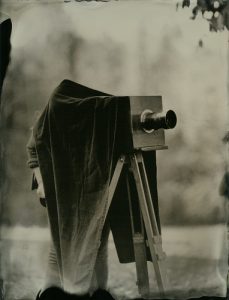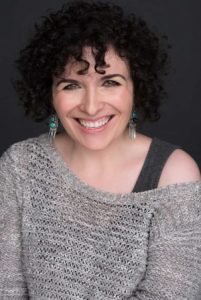 Editorial assistant Lucia Sabo recently reached out to Colorado Review contributor Jehanne Dubrow. Here is the interview that followed.
Editorial assistant Lucia Sabo recently reached out to Colorado Review contributor Jehanne Dubrow. Here is the interview that followed.
Lucia Sabo: Your essay “Portrait on Metal with Patterned Scarf and Streak of Light” was featured in the fall 2019 issue of CR. It is clear from the essay that your writing has been informed by history, psychology, art, and scholars such as Freud and Sontag. Did you find, while crafting this essay, that you were drawing on a bank of knowledge from within, or was it a research-and-reflection process?
Jehanne Dubrow: What a great question! I think this essay combines prior knowledge that I brought to the page with research and reflection. For instance, both Freud and Sontag are touchstones for me and have often informed my poems and essays. So, I already had them in mind when I decided I wanted to write about the intersection between beauty, aging, and photography. But, as I sat for my tintype portrait, I was very aware that I knew almost nothing about the technology. The photographer who took my picture, Ellen Marie Leathers-Wishart (http://www.ellenwishart.com), was extremely informative and eager to explain the process to me, and I loved being able to include her voice in the essay.
But, of course, I ended up having to do additional research, once I was facing the challenge of trying to narrate my experience of being in the tintype studio. And it was the research that led me to some of the central metaphors of the essay, including the one that comes near the end of the piece: “Is this what aging means—that the light will no longer touch me?” This has often been my experience, that the research can help me to discover a text’s essential metaphors, the figurative often rooted in the literal.
LS: I found it interesting that you felt closer to the photo of yourself as a young girl reading than to the heavily edited, professional photos. There is a poignant central concern appearing for me at that point in the essay. Are you drawn to the older photo—feeling it is still your most true and honest expression—as a means of reconnecting with the past?
JD: This feels shameful to admit, especially in an era when so many of us are aspiring to engage in body positivity. But, I feel closer to the childhood picture of myself because I miss that time when I was pretty without the assistance from special lighting or flattering angles or any kind of makeup. These days, if I want to look lovely in a picture, there’s a lot of work that goes into making that happen!
I was a pretty child. In fact, this was a constant refrain of my childhood, people always commenting on my face, my smile. My parents were American diplomats, and my prettiness was often used—perhaps subconsciously—in the service of their work; because I was well-spoken, well-behaved, and consistently presentable, I could be relied upon to perform well in social settings. I’ve come to dislike cocktail parties and other formal events because, in my childhood, I was frequently asked to sparkle and shine at embassy functions.
LS: One of my favorite moments in the essay happens when your face, in the tintype, “melts into being.” Then, thinking about the image developing in reverse and referring to this process as your face “spreading out into ripples” reads beautifully as references to birth and death. Was this an intentional connection for you? If not, how might you feel about readers drawing that conclusion?
JD: I think this reading makes a lot of sense. The central anxiety of the essay is of aging, how women begin to disappear as they age, how in losing our beauty (or at least, losing what might be called “youthful beauty”) we simply fade out of sight. Obviously, I wish things were different. And, in some way, I hope that by addressing my own vanity and insecurity in this essay, I’m helping to critique this way of seeing women as they age. Recently, I was reflecting on my dissertation advisor, a brilliant, fierce woman; I used to think of her as “The Empress.” She was incredibly accomplished, completely secure in her knowledge and expertise, and so sure of how to move through the world in her body. She had such a way of wearing a scarf. I loved her style, that it was evident she wasn’t disappearing, that she had found a way to be seen. When I grow up, I want to be The Empress too.
LS: I am interested in your connection to Mary Cassatt’s portraits of young women reading in pastels. At what point in your life did you begin to identify with the women in these paintings? Additionally, do you have a favorite painting of hers, or one you most identify with?
JD: In thinking about your question, I went back and looked at a number of my favorite pieces by Mary Cassatt. They were all of women and girls reading! What I love about the images is that they imply indifference. The women and girls are being consumed, gazed upon, but they don’t care. They’re too involved in the words before them to notice that they’re being watched. And maybe this connects with your earlier question about why I was so drawn to that childhood photograph of myself. I love the picture that my father carries in his wallet, the one where I’m five years old and reading, because I’m already so full of concentration and thought in that snapshot.
LS: Can you describe the experience of deciding to smile for the tintype photograph instead of maintaining a blank expression? I am curious because you go on to say, “What pierces me is that I cannot believe this face is who I am. ” Do you feel as though that sentiment would be different if you had a neutral expression? In other words, do you feel like what was unrecognizable was the insincerity of smiling for photos?
JD: As I say in the essay, I always smile in photographs. Even though I first learned to smile for photographs as a kind of trick—it was a technique my father taught me, a way of ensuring that I always stood out in pictures, a forced smile that somehow appears real and natural on film—the trick has become genuine over time. I feel unlike myself when I don’t smile in pictures.
“Portrait on Metal with Patterned Scarf and Streak of Light” is part of a collection of essays that I’m currently finishing. Exhibitions, as I’m tentatively calling the manuscript, explores works of art as a means of considering my Foreign Service upbringing. I was born in Italy and grew up in Yugoslavia, Zaire, Poland, Belgium, Austria, and the United States. Many of the other essays in the collection consider genocide, intergenerational transmission of trauma, and the ethical problems of representing atrocity through the beautiful. So, this particular essay is a little less focused on history and more directed toward the immediate worries of the self. But I think it also intersects with some of the book’s concerns about the beautiful: the ethical problems of beauty, the way we confuse the beautiful with the good, and how we contort ourselves in the service of beauty.
Jehanne Dubrow is the author of seven poetry collections, including American Samizdat, and a book of creative nonfiction, throughsmoke: an essay in notes. Her work has appeared in Virginia Quarterly Review, Pleiades, and the Southern Review. She is an associate professor of creative writing at the University of North Texas.
